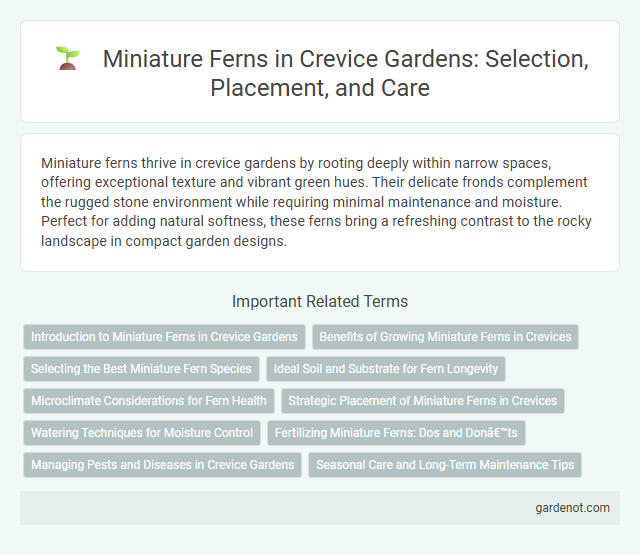Miniature ferns thrive in crevice gardens by rooting deeply within narrow spaces, offering exceptional texture and vibrant green hues. Their delicate fronds complement the rugged stone environment while requiring minimal maintenance and moisture. Perfect for adding natural softness, these ferns bring a refreshing contrast to the rocky landscape in compact garden designs.
Introduction to Miniature Ferns in Crevice Gardens
Miniature ferns are ideal for crevice gardens due to their compact size and ability to thrive in narrow, rocky gaps. These ferns exhibit delicate fronds that add lush greenery and texture, enhancing the naturalistic aesthetic of crevice planting designs. Their resilience to varying moisture levels and shaded environments makes them a perfect choice for maintaining year-round interest in crevice gardens.
Benefits of Growing Miniature Ferns in Crevices
Miniature ferns thrive in crevice gardens by efficiently utilizing narrow spaces where moisture and shade conditions are ideal for their growth. Their compact size allows them to add lush, textured greenery to rocky crevices, enhancing biodiversity and visual interest without overcrowding. These ferns improve air quality and help stabilize soil within crevices, contributing to an eco-friendly garden environment.
Selecting the Best Miniature Fern Species
Selecting the best miniature fern species for a crevice garden involves prioritizing varieties such as Asplenium trichomanes and Polypodium vulgare, which thrive in rocky, shaded environments with excellent drainage. These ferns exhibit compact growth habits, making them ideal for narrow crevices and limited soil pockets, while their resilience to drought and variable temperatures ensures longevity. Opting for species with fine-textured fronds enhances the garden's visual appeal and mimics natural alpine habitats effectively.
Ideal Soil and Substrate for Fern Longevity
Miniature ferns in crevice gardens thrive best in well-draining, humus-rich soil that retains moisture without becoming waterlogged. A substrate blend of peat moss, coarse sand, and organic compost promotes aeration and mimics the fern's natural forest floor habitat. Consistent moisture levels and slightly acidic pH around 5.5 to 6.5 enhance fern longevity and vibrant growth in crevice garden environments.
Microclimate Considerations for Fern Health
Miniature ferns thrive in crevice gardens where microclimates with consistent moisture and shade are prevalent. These plants require high humidity and well-drained, acidic soil to prevent desiccation and root rot. Positioning ferns in protected niches minimizes temperature fluctuations, promoting optimal growth and vibrant foliage.
Strategic Placement of Miniature Ferns in Crevices
Strategic placement of miniature ferns in crevices enhances both aesthetic appeal and plant health by providing natural moisture retention and protection from direct sunlight. Positioning these ferns in shaded, narrow gaps within rocks mimics their natural habitat, promoting optimal growth and preventing desiccation. Careful spacing ensures adequate airflow, reducing the risk of fungal infections while supporting the fern's delicate root systems.
Watering Techniques for Moisture Control
Miniature ferns in crevice gardens require consistent moisture without waterlogging, best achieved through drip irrigation systems or misting to maintain humidity. Using a well-draining soil mix, such as one with added perlite or sand, helps prevent root rot while retaining necessary moisture levels. Regularly monitoring soil moisture with a hygrometer ensures optimal hydration, promoting healthy growth and vibrant fronds.
Fertilizing Miniature Ferns: Dos and Don’ts
Fertilizing miniature ferns requires a balanced approach using a diluted, water-soluble fertilizer with a nitrogen-phosphorus-potassium (NPK) ratio of 10-10-10 or 20-20-20 every 4-6 weeks during the growing season. Avoid over-fertilizing, which can cause leaf burn and inhibit growth, and never apply fertilizer to dry soil to prevent root damage. Proper timing and concentration are essential to maintain healthy foliage and vibrant miniature fern growth in crevice gardens.
Managing Pests and Diseases in Crevice Gardens
Miniature ferns in crevice gardens require vigilant pest management to prevent infestations by aphids, spider mites, and scale insects, which thrive in the confined spaces of rock walls. Implementing organic insecticidal soaps and neem oil treatments effectively controls these pests without damaging the delicate fern fronds or surrounding rock flora. Regular inspection and maintaining proper air circulation in narrow crevices reduce fungal diseases like powdery mildew and root rot, ensuring healthy miniature fern growth.
Seasonal Care and Long-Term Maintenance Tips
Miniature ferns in crevice gardens require consistent moisture during the growing season, achieved by regular misting and well-drained soil to prevent root rot. During winter, reduce watering and protect them from frost by mulching or relocating to a sheltered spot to ensure survival. Long-term maintenance includes pruning dead fronds and periodically checking for pests to sustain healthy growth and vibrant foliage.
Miniature fern Infographic

 gardenot.com
gardenot.com